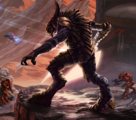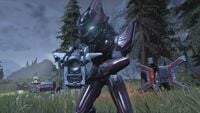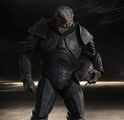Kaidon
From Halopedia, the Halo wiki
| Kaidon | |
|---|---|
| File:Sangheili Clan Leader.jpg | |
| Political information | |
|
Type: |
Head of government |
|
Government: |
Sangheili city-states |
|
Duties: |
Rule of a Sangheili state |
|
Headquarters: |
Head keep |
| Historical information | |
|
Notable individuals: |
|
Kaidon, or "lord",[1] is a meritocratic rank held by the head of a Sangheili state. Kaidons are chosen by a council of elders from their state.[2]
Overview
Kaidons are elected by a panel of their clan's elders. After the kaidon has taken office, any elder who disagrees with the crowning of the new leader sends assassins to kill him or challenges the kaidon himself, as a form of testing whether the new leader is worthy of ruling the clan.[3] Should the assassins fail, the sender is typically executed. However, if the kaidon is killed, no action is taken against the elder, as the Sangheili believe that a kaidon who cannot defend himself is unworthy of leadership.[4] Any treasonous or disloyal individual that lived in the state that the kaidon governed could be executed by the kaidon.[5]
Kaidons, despite being political rulers, are very active in the military, even leading long campaigns into enemy territory, leaving the elders to rule in his stead.[6] Although a kaidon may be protected by numerous armed guards, the kaidon typically removes any threats himself to show that he is a capable leader. A kaidon typically arms himself with an energy sword and may wield a ranged weapon, such as a plasma pistol, as a sidearm. Kaidon is a life-long rank, so the next kaidon is crowned only after the current kaidon dies.[2] In accordance with Sangheili tradition, only males can attain the title of kaidon. As female offsprings of a kaidon are unable to claim their fathers' lands and possessions, other kaidons might contest for a daughter's inheritance by attempting to secure their hand in marriage, either to themselves or to one of their sons. Sangheili history is filled with instances where kaidon daughters rejected suitors and fought them off for years, such as in the case of the Gray Maiden of Konar. Such daughters are given the noble title of Scion.[7]
Kaidons reside within a High Room, located in the kaidon's own keep. The keep that the kaidon lives in is considered the head keep of the state, with there being numerous client keeps controlled by clan elders. A kaidon meets with the elders of the state's client keeps within an assembly house located inside the head keep where matters concerning the state are discussed.[8]
The Refuge was also led by a kaidon. After Kaidon Ussa 'Xellus was forced to leave his state on Sanghelios, he continued to lead the Refuge as its kaidon. After Ussa's death, the Refuge continued to be led by a kaidon by members of the Xellus clan. In the event of a kaidon's absence, another high-ranking Sangheili could be given the "necklace of rank" and serve as the "acting kaidon".[9] During Bal'Tol 'Xellus' term as kaidon, Oska 'Meln challenged his authority and led a rebellion throughout different sections of the Refuge. 'Meln declared himself the kaidon and told his followers that 'Xellus was a "false kaidon".[10]
Known kaidons
Deceased
- Orok 'Darsam – A kaidon and the uncle of the demigod hero Kel 'Darsam in ancient Sangheili mythology.[11]
- Nesh 'Radoon – A powerful sea lord and rival kaidon of 'Darsam in ancient Sangheili mythology.[11]
- Ther 'Vadam – An ancient kaidon of the state of Vadam. After losing a war against one of his clan's rivals, he was imprisoned, though he eventually escaped. He spent years gathering allies, with whom he one day attacked his enemies' keep. He executed his enemies, as well as his former companions who were too cowardly to commit suicide.
- Ussa 'Xellus – Kaidon of the state of Xellus until the state's destruction in 851 BCE; later the first kaidon of The Refuge.[12]
- N'Zursa 'Xellus – Former kaidon of the Refuge and Bal'Tol 'Xellus' uncle.[13]
- Tulum 'Juranai – Former kaidon of the largest settlement on the colony Rahnelo.[14]
- Gerdon 'Hilot - Former kaidon of the city-state of Hilot.[15]
- Thav 'Sebarim - Kaidon of Malaston keep who later joined the Banished. Killed by John-117 on Installation 07 in 2560.
Existing
- Thel 'Vadam – The latest known kaidon of Vadam; killed the assassins sent by the elder Koida 'Vadam, then executed the latter and banished his family. Later he became the Supreme Commander of the Fleet of Particular Justice, and the Arbiter after that. After becoming the Arbiter, he killed the Prophet of Truth, effectively ending the Human-Covenant War. After the Great Schism, he sought reconciliation with humanity following the war, drawing ire from more conservative Sangheili.[16]
- Unidentified kaidon of Moram – This kaidon was the target of a coup attempt by Ripa 'Moramee, one of his clanmates. 'Moramee's attempt failed and he was brought before the kaidon, who banished him to the Weeping Shadows of Sorrow penitentiary. 'Moramee's resolve during the coup led to his ascension to the rank of Arbiter.[17]
- Levu 'Mdama – Kaidon of the state of Mdama following the Human-Covenant War in 2553. Allied himself with Thel 'Vadam and sought reconciliation with humanity.[16]
- Panom – Kaidon of the State of Panom on Hesduros. Allied himself with Jul 'Mdama and formed a new Covenant to find the Didact's shield world, Requiem.[18]
- Bal'Tol 'Xellus – Kaidon of the Refuge as of 2553. Ended the 'Greftus Faction rebellion.[19]
- Tulum 'Juranai's youngest son – Kaidon of Rahnelo's largest settlement as of 2553.[14]
- Dinnat 'Hilot's mate - Chosen as Gerdon 'Hilot's replacement as kaidon of Hilot.[15]
- Rojka 'Kasaan - Former kaidon of the city-state of Rak on Carrow. In 2558, after quelling the opposition of Thars 'Sarov and helping prevent a planetary crisis, he returned to Rak and relinquished leadership to Kaidon Akato 'Dakaj.[20]
- Akato 'Dakaj - A lesser kaidon who assumed control of Rak in 2558 following Thars' rebellion on Carrow.[20]
Trivia
Eric Nylund's Halo: Ghosts of Onyx makes references to "Major Domo Sangheili".[21] As a "majordomo" is the head (or acting head) of a household, it could be that this was an early concept for the kaidon or elder titles introduced in Halo: The Cole Protocol.
Gallery
Kaidon Thel 'Vadam in Halo Mythos.
Kaidon Thav 'Sebarim in Halo Infinite.
A Kaidon in Halo: The Television Series.
List of appearances
- Halo 3 (Mentioned in Halo: The Master Chief Collection-only)
- Halo: The Cole Protocol (First appearance)
- Halo Wars: Genesis
- Halo: Glasslands
- Halo: The Thursday War
- Halo: Escalation
- Halo: Broken Circle
- Hunt the Truth
- Halo 5: Guardians
- Halo: Shadow of Intent
- Halo Fractures
- Lessons Learned (Mentioned only)
- Halo: Envoy
- Halo Infinite
- Halo: The Television Series
Sources
- ^ Halo: Official Spartan Field Manual, page 150
- ^ a b Halo: The Cole Protocol, page 89
- ^ Halo: Glasslands, page 171
- ^ Halo: The Cole Protocol, page 92
- ^ Halo: Broken Circle, page 47
- ^ Halo: The Cole Protocol, page 94
- ^ Halo: Shadow of Intent, page 19 (Google Play edition)
- ^ Halo: Glasslands, page 53
- ^ Halo: Broken Circle, page 278
- ^ Halo: Broken Circle, page 272
- ^ a b Halo: Shadow of Intent, page 22 (Google Play edition)
- ^ Halo: Broken Circle, page 46
- ^ Halo: Broken Circle, page 203
- ^ a b Halo: Shadow of Intent, page 18 (Google Play edition)
- ^ a b Halo: Fractures, "Lessons Learned", page 23-24
- ^ a b Halo: Glasslands, page 59
- ^ Halo Wars: Genesis
- ^ Halo: The Thursday War, page 441
- ^ Halo: Broken Circle, page 206
- ^ a b Halo: Envoy, page 372
- ^ Halo: Ghosts of Onyx, page 349
| |||||||||||||||||||||||||||||||||||


